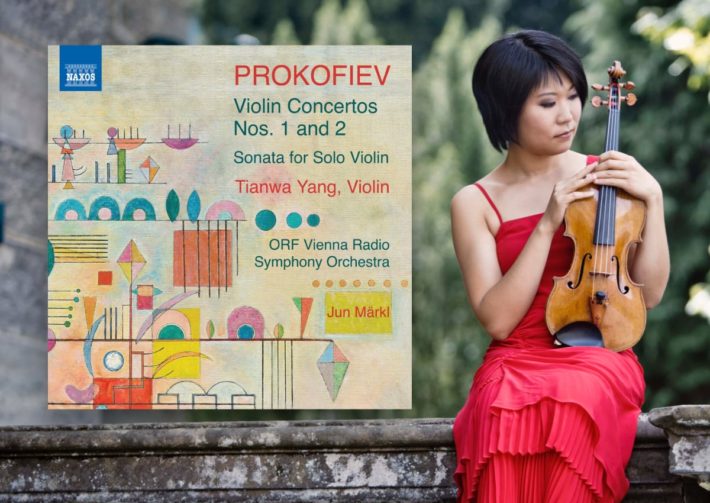Image: ©️ Irène Zandel
In March of this year, I wrote that Hillary Hahn’s new performance of Prokofiev’s first violin concerto (see review) was technically immaculate, but emotionally cool. This new performance operates on an altogether higher emotional level. Yang and Märkl fully inhabit the music’s many mood changes: the first movement’s quixotic opening has a shimmering delicacy, while the first lyrical outburst (1’44”) is fulsome and impassioned.
The middle section’s playfulness is heightened by the orchestra’s nimbleness and Yang’s complete mastery of every technical hurdle. Her energy and enthusiasm are infectious, inspiring her orchestra colleagues to relish Prokofiev’s glittering and detailed accompaniment. The mood change at 6’50” is compellingly handled, creating a potently mysterious atmosphere, leading into a particularly haunting duet between the violin and flute.
The “Scherzo” that follows has the wild savageness that was missing from Hahn’s performance. Märkl sets the right tone, angry, sardonic, and driven. Yang playing is a virtuosic tour-de force, the music’s many string-crossings and double/triple stopped chords immaculately as Prokofiev’s motor rhythms threaten to send the music off the rails. Märkl and the Naxos engineers ensure we hear lots of orchestral detail, which only adds to the sense of unrestrained hijinks. The closing Moderato very much captures the composer’s sarcastic wit, the quiet coda particularly affecting.
In previous recordings I have found Märkl’s conducting to be somewhat neutral, but here he proves to be an alert and attentive accompanist, following his soloist’s every interpretative nuance. The orchestral playing is uniformly excellent, the orchestral color having an authentic Slavic darkness.
The second Concerto, Prokofiev’s last Western commission, is an altogether more somber affair. Written in 1935, just as the composer was preparing to return to the Soviet Union, the opening violin solo suggests many things: the painful homesickness that led to his decision to return to the Soviet Union, or perhaps trepidation about returning to a country under the authoritarian control of Stalin. Yang and the orchestra embrace this emotional ambiguity, with playing that conjures a sarcastic and ominous mood, though the second theme has a brighter luxuriousness seemingly cut from the same cloth as the Romeo and Juliet ballet. Perhaps Prokofiev was trying his hand at writing the kind of music the Soviets would expect when he returned home?
Related Classical Music Reviews
- Review: Prokofiev – Symphony No. 5 – Oslo Philharmonic, Petrenko
- Review: “Journey Through a Century” – Sueye Park, Violin
- Review: Elgar – Violin Concerto – Nicola Benedetti, Violin
The same lyric beauty is heard in the opening of the second movement, one of Prokofiev’s most sublime melodies, played by Yang with fulsome ardor. Throughout the work, one notes that the music is more difficult than it sounds – Yang’s technical brilliance makes it seem almost effortless. Märkl and his players once again reveal lots of orchestral detail, and I particularly like how the atmosphere becomes chillier and gloomier in the Coda. The finale with its castanets (probably a nod to the concerto’s premiere in Spain), begins as a lighthearted waltz, but the insistent bass drum continually chips away at such frivolity, distorting the waltz and dragging the music into a more militant mood. As the writing becomes increasingly angular, Yang layers in a ferocity that never becomes overly harsh – the final chords dismissive and emotionally ambiguous.
Yang’s approach is like Janine Jansen’s outstanding performance, and if I prefer Jansen more, it is only because Decca’s recording has more presence (the bass drum strokes even more potent) and Jurowski’s accompaniment uncovers even more orchestral detail.
The “Sonata for Solo Violin,” written in 1947, was commissioned by the Soviet Union’s Committee of Arts Affairs as a pedagogical work. Its premiere was played by 20 student violinists in unison. While the music is mainly diatonic, there are several technical challenges that suggest those 20 students were particularly gifted. It is another example of Prokofiev’s ability to write immediately accessible music that was intended for children without sounding in any way childish. Yang plays the music with great charm and sincerity, finding a touching emotional depth in the theme and variations of the second movement.
Daniel Jaffé’s liner notes are thoughtful and informative. The Naxos recording, made in November 2020 at the Grosser Sendesaal, ORF Funkhaus in Vienna, captures all three performances in a warm and open acoustic, the violin beautifully balanced without ever dominating the aural picture.
There are, of course, numerous recordings of these works, played by some of the greatest violinists, past and present. But this new recording can take its place among those greats, with readings that capture the music’s brilliance and profundity. Warmly recommended.

Prokofiev: Violin Concertos Nos. 1 & 2; Sonata for Solo Violin
Tianwa Yang – Violin
Vienna Radio Symphony Orchestra – Jun Märkl, Conductor
Naxos, CD 8574107
Recommended Comparisons
Read more classical music reviews or visit The Classic Review Amazon store
Follow Us and Comment:
[wd_hustle id=”HustlePostEmbed” type=”embedded”]











